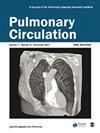Safety of inhaled nitric oxide withdrawal in severe chronic pulmonary hypertension
IF 2.2
4区 医学
Q2 CARDIAC & CARDIOVASCULAR SYSTEMS
引用次数: 0
Abstract
Inhaled nitric oxide (iNO) is a potent and selective pulmonary vasodilator with a safety concern due to rebound pulmonary hypertension (PH) associated with its withdrawal. We report short-term pulsed iNO in patients with severe pulmonary arterial hypertension (PAH) and nonoperable chronic thromboembolic PH (nCTEPH). This is a retrospective analysis of 33 patients: 22 with PAH and 11 with nCTEPH. We assessed hemodynamic, echocardiographic, and other noninvasive variables to evaluate safety and efficacy of iNO. We performed an iNO withdrawal test during right heart catheterization and after 3 days of iNO treatment. iNO significantly improved all variables examined in 22 patients with PAH and 11 with nCTEPH. Two patterns of response were observed after sudden iNO withdrawal. Twenty-nine patients (88%) showed minimal hemodynamic, oxygenation and clinical changes. Four patients (12%) had a reduction in cardiac index ≥20% and PaO2 ≥ 5%, three patients did not show clinical deterioration, and one patient developed hemodynamic collapse that needed iNO administration. This retrospective study suggests that short-term iNO improves hemodynamics and clinical conditions in some patients with PAH an nCTPEH. However, pulsed iNO withdrawal PH rebound could be a serious concern in these patients. Given the lack of evidence, we do not recommend the use of pulsed iNO in the treatment of patients with chronic PH.重度慢性肺动脉高压患者停用吸入一氧化氮的安全性
吸入一氧化氮(iNO)是一种强效的选择性肺血管扩张剂,但由于停药会导致肺动脉高压(PH)反弹,因此存在安全隐患。我们报告了严重肺动脉高压(PAH)和不能手术的慢性血栓栓塞性肺动脉高压(nCTEPH)患者的短期脉冲一氧化氮治疗。这是一项对 33 名患者的回顾性分析:其中 22 例为 PAH 患者,11 例为 nCTEPH 患者。我们评估了血液动力学、超声心动图和其他无创变量,以评估 iNO 的安全性和有效性。我们在右心导管检查期间和 iNO 治疗 3 天后进行了 iNO 停药测试。在 22 名 PAH 患者和 11 名 nCTEPH 患者中,iNO 可显著改善所有检查变量。在突然停用 iNO 后观察到两种反应模式。29 名患者(88%)的血液动力学、氧饱和度和临床变化极小。4名患者(12%)的心脏指数下降≥20%,PaO2≥5%,3名患者未出现临床恶化,1名患者出现血流动力学衰竭,需要给予 iNO。这项回顾性研究表明,短期 iNO 可改善部分 PAH 和 nCTPEH 患者的血流动力学和临床状况。然而,脉冲式 iNO 的停药 PH 反弹可能是这些患者的一个严重问题。鉴于缺乏证据,我们不建议使用脉冲 iNO 治疗慢性 PH 患者。
本文章由计算机程序翻译,如有差异,请以英文原文为准。
求助全文
约1分钟内获得全文
求助全文
来源期刊

Pulmonary Circulation
Medicine-Pulmonary and Respiratory Medicine
CiteScore
4.20
自引率
11.50%
发文量
153
审稿时长
15 weeks
期刊介绍:
Pulmonary Circulation''s main goal is to encourage basic, translational, and clinical research by investigators, physician-scientists, and clinicans, in the hope of increasing survival rates for pulmonary hypertension and other pulmonary vascular diseases worldwide, and developing new therapeutic approaches for the diseases. Freely available online, Pulmonary Circulation allows diverse knowledge of research, techniques, and case studies to reach a wide readership of specialists in order to improve patient care and treatment outcomes.
 求助内容:
求助内容: 应助结果提醒方式:
应助结果提醒方式:


